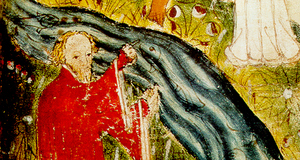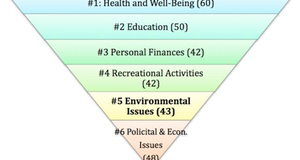Mysticism and Christianity in Early English Literature: Comparing Beowulf and Sir Gawain and the Green Knight
By
2010, Vol. 2 No. 07 | pg. 1/1
KEYWORDS:
The introduction of Christianity to England in 597 established a structured, uniform faith among a people accustomed to different branches and pockets of polytheistic paganism. Over the next seventy-five years, the burgeoning country quickly grew unified under the tenets of Catholicism, transforming many of the practices of their ancestors into Christian traditions. However, the fusion of the two religions reshaped more than the Britain’s spiritual beliefs. Remnants of pagan mysticism and magic blurred and interwove with themes from the Bible to create proselytizing legends. An Old English epic poem, Beowulf, draws on Christianity to rationalize some of its supernatural elements, turning the pre-conversion myth into a lesson on faith. By contrast, the Middle English romance, Sir Gawain and the Green Knight, uses mysticism and magic to explore popular ideas and stories of the Catholic belief. Despite their inverse approaches, these two narratives communicate the same message to the reader: trust and rely on the Christian God, or fail. Set vaguely around the age of England’s Danish predecessors, the Beowulf legend describes a historically non-Christian era. The poet’s Catholic faith manifests itself in his writing, though. Many of the tale’s supernatural characters reinterpret in Biblical passages. Grendel, his mother, and other “ogres and elves and evil phantoms” are descendents of “Cain’s clan, whom the Creator had outlawed / and condemned as outcasts” (Beowulf 36). As God told Cain, “’You will be a restless wanderer on the earth,’” so did the monster go “marauding round the heath / and the desolate fens” (Holman Christian Standard Bible, Gen. 4: 12; Beowulf 36). Grendel’s fellow terrors, “the giants too who strove with God / time and again,” could be the Nephilim of Scripture (Beowulf 36). These hybrid creatures, “the powerful men of old, the famous men,” are the children of the fallen angels and mankind from “when the sons of God came to the daughters of man” (Gen. 6: 4). Offspring of corruption, they are “men of great size” who make humans feel “like grasshoppers” (Num. 13:33). By giving Grendel and his wretched fellow monsters a Biblical origin, the poet makes the mysticism of the myth more palatable to fellow believers. The demons one must avoid are religiously threatening as well as physically. Faith in God can ward them off. Beowulf also relies on Christian beliefs to explain the happenings and situations of the plot. God directs and enables the hero to deliver Heorot from danger. In his struggle with Grendel’s mother, Beowulf credits God with his superhuman success: “If God had not helped me / the outcome would have been quick and fatal” (Beowulf 69). The man everyone recognizes as a hero and powerful nobleman on sight derives his strength from the Lord’s help. Similarly, the people of the poem believe God is responsible for punishing their offenses, not just rewarding their bravery. Upon learning that “his own home” had been destroyed by the dragon, Beowulf “thought he must have thwarted / ancient ordinance of the eternal Lord, / broken his commandment” (83). The poet attributes the cause of Beowulf’s staggering strength and the misfortune of his decimated house to the object of his faith.The title character’s relationship with God accounts for the tragedy of his death in order to warn readers and listeners against taking the Lord for granted. Despite Hrothgar’s counsel, “’Do not give way to pride. / For a brief while your strength is in bloom / but it fades quickly…. And death will arrive / to sweep you away,’” Beowulf refuses to consider his age before chasing the dragon (71). Instead, the poet writes, he is “too proud / to line up with a large army / against the sky-plague. He had scant regard / for the dragon as a threat, no dread at all / of its courage or strength” because he was accustomed to winning in the past (83). His conceit is his undoing. As the famous maxim reads, “Pride goes before destruction, and an arrogant spirit before a fall” (Prov. 16:18). This adage underscores the lesson Beowulf might have learned earlier: to believe oneself invincible is to not rely on God. Without the help of his warriors, who fled before the dragon, the proud king—and by extension, the readers—realizes that “every man must yield / a leasehold of his days” (Beowulf 88). No one can fool God into escaping his own mortality. The writing and story of Sir Gawain and the Green Knight effectively convey this same message, but through an inverse manner. The tale of Arthur’s nephew is not a mystical story made religious, but a religious story with elements of magic to illustrate Christian lessons for the reader. The Green Knight, for example, in many ways represents God. The Ten Commandments are a form of agreement between man and the Father; God promises to show “faithful love to a thousand generations of those who love [Him],” seek Him, and His laws (Ex. 20: 6). Likewise, Gawain enters a “covenant” with the supernatural man, who says, “Cease not to seek till me, sir, you find / as you promised…To the Green Chapel, come” (Sir Gawain 171). The knight of Arthur’s court thus makes a promise similar to that of a Christian follower. Gawain’s journey even leads him to a house of God. While a quest for a Green Knight would be difficult for readers to copy, a spiritual pilgrimage to be closer to God is within the realm of possibility. The beautiful wife of Bertilak reads strongly of two Biblical women, bringing alive the stories of Adam and Eve and of the temptation of Joseph. Unlike Grendel’s mother, who threatened men by acting like a man, the Lady of Bertilak is dangerous because she can manipulate her femininity and sexuality to tempt the opposite sex. When she comes to Gawain the third time, she uses her body to seduce Gawain into sin: “Her face and fair throat [were] freely displayed / Her bosom all but bare, and her back as well” (197). The woman is clever as well, speaking with “artful words” and twisting his meaning to confuse and “hem him about” (198). Eve, who wore no clothes in the Garden, spoke to her husband and convinced him to eat from the Tree of Knowledge. Like Adam, Gawain cannot resist accepting her offer of the forbidden. The Lady also symbolizes Potiphar’s wife, another temptress. When her husband was out working, the woman came to Joseph, her slave, and tried to entice him into her bed. Gawain dedicates himself to the Lady, swearing, “I prize the praise you have proffered me here / and soberly your servant, my sovereign I hold you / and acknowledge me your knight, in the name of Christ” (Sir Gawain 188). She pushes her body toward him as her servant while her husband is out. Like the story’s original protagonist, Gawain must refuse his mistress every day without angering or upsetting her. Unlike Joseph, however, Gawain does not trust his fate in the hands of God enough to refuse the Lady’s girdle. The Veneries echo the temptations of Jesus; Gawain must withstand three occasions of temptation, just as Christ thrice had to refuse Satan’s lures. Just as the Devil tempts him in three different ways, the Lady’s tactics change a little with each visit. On the first occasion, she openly offers her body to him: “My body is here at hand, / Your each wish to fulfill; / Your servant to command / I am, and shall be still” (Sir Gawain 187). Second, she tries to guilt him into crossing the line, arguing, “Here by your side I have sat for two days / Yet never has a fair phrase fallen from your lips / of the language of love …. Do you deem me so dull, or so deaf to such words?” (193). On the third instance, she begins to ply him with objects of hers. Despite the symbols of perfection he bears, such as the Pentangle, Gawain is not as flawless as the Christ. He does not succeed in keeping above sin. By exchanging the kisses for Bertilak’s fox without returning the belt, Gawain takes on the symbolic actions of Judas. He betrays his host with a kiss. The writer brings these Bible stories to life by dressing them up in the form of a romantic tale with new circumstances. Through his title character’s surrender to temptation, the Gawain poet emphasizes the shameful consequences of too little faith in God. Gawain, whose virtue and integrity made him “the noblest knight known in [his] time,” was able to reject the Lady’s allure until a promise of escape from imminent death presented itself (Sir Gawain 193). Once Gawain presumes to avoid his own mortality, he breaks the covenants that he has so long protected and must forevermore live with the dishonor of the green girdle on his arm. “Gripped with grim rage” at his own weakness, he asks to keep the belt to “remember with shame / the faults and the frailty of the flesh perverse” (210). His sign is adopted by the whole Arthurian court, which had feared death too much to accept the Green Knight’s bet the year before. They ironically take on the symbol of his badge of humiliation before the Lord, unknowingly bearing the sign of their own cowardice. Thus the poet demonstrates that everyone fails to trust God enough to rely on His protection. The writers of Beowulf and Sir Gawain and the Green Knight approach the theme of trust with two opposite strategies. Where one rationalizes the magical with the religious, the other enlivens and demonstrates the Bible stories with elements of the supernatural. The dynamic relationship between Christianity and mysticism, begun by missionaries at the turn of the seventh century, provides the backdrop for one of Catholicism’s most important lesson in faith. Readers and listeners of both periods, Anglo-Saxon and Middle English, could enjoy the narratives’ excitement and intrigue while internalizing the message to place all trust in the Lord. These surviving texts still speak to modern audiences, encouraging the same faithful behavior of the current generation of readers. ReferencesBeowulf. The Norton Anthology of English Literature. Ed. Stephen Greenblatt. Trans. Seamus Heaney. 8th ed. New York: W. W. Norton & Company, 2006. 34-100. Sir Gawain and the Green Knight. The Norton Anthology of English Literature. Ed. Stephen Greenblatt. Trans. Seamus Heaney. 8th ed. New York: W. W. Norton & Company, 2006. 162-213. The Holy Bible, Holman Christian Standard Edition. Nashville: Holman Bible Publishers, 2003. Suggested Reading from Inquiries Journal
Inquiries Journal provides undergraduate and graduate students around the world a platform for the wide dissemination of academic work over a range of core disciplines. Representing the work of students from hundreds of institutions around the globe, Inquiries Journal's large database of academic articles is completely free. Learn more | Blog | Submit Latest in Literature |
















